Infrasound
in ATMOSPHERE And ITS CONNECTION With
SPACE And GEOSPHERic PROCESSES
Soroka S.A. , Kalita B.I., Mezentsev
V.P., Karataeva L.M.
The Lvov
centre of the
Institute
of Space Researches NSA-NAS
of
Ukraine
(LC ISR)
Infrasound
fluctuation in the Earth atmosphere resulted from the action of numerous
geospheric processes and processes in near space. Action of the energy of a
space origin on the Earth processes is usually connected to electromagnetic
radiations and solar
corpuscular flows. The interaction of electromagnetic radiation with
heterogeneities of the atmosphere transparency can result in generation of
acoustic fluctuations in a wide range of frequencies. It is important to note,
that the transparency heterogeneities of the atmosphere are significantly
determined by solar activity (SA). One can expect, that in the spectrum of the
infrasound fluctuations of the atmosphere (IFA) the
SA rhythmic should
be manifested. The
widely known connection of SA with biospheric processes can occur through the
acoustic channel [1,2,3].
The
IFA are caused by seismic activity. In this case it is possible to consider
two situations. The IFA can be both the external influence on preparatory
processes and their result.
It
is known, that the intensity of seismic processes is caused by SA. This
connection was found during the analysis of global seismicity on the Earth and
the 11-year cycles of SA. It is considered, that this connection occurs
through cyclonic activity in the atmosphere. However it is possible to assume,
that SA influences the intensity of the infrasound waves in the atmosphere,
which, in turn, influence the seismic processes. Thus, the Sun, interplanetary
environment, atmosphere and lithosphere represent a uniform system, in which
the infrasonic waves play an essential role during interaction of geospheres.
In
LC ISR the researches are carried out in three directions:
 |
researches of the influence of SA on infrasonic
fluctuation in the Earth atmosphere; |
 |
researches of connection of seismic activity with infrasound in the
atmosphere; |
 |
researches of the influence of artificial acoustic disturbance on the
“atmosphere –
ionosphere system”. |
The
purpose of the first direction researches was the search of rythmic solar
activity in the atmospheric infrasound spectrum. As a result of the analysis
of the infrasound spectrum for the period of 1997-2000 the annual, seasonal,
27 daily and daily periods of fluctuations were found out. The hypothesis
about the increase in infrasound energy with reduction of SA was confirmed.
The diagram of the influence mechanism of SA on IFA was proposed.
Within
the framework of the second direction, the researches of infrasound changes
before large earthquakes and after them were carried out. If to assume, that
the preparation of large earthquake is accompanied by small changes in seismic
activity on the large territory, these changes will
not be noticeable during
seismic measurements at one point.
In IFA the large changes due to their integrated character and due to the
dependence on many factors, accompanying
preparation of earthquakes on the large territories, can be observed. The
characteristic changes of the spectrum and phase diagrams of infrasonic
fluctuations in the atmosphere before large earthquakes are found out as a
result of the carried out researches.
When
performing researches in the third direction the numerous experiments on
observation of the electromagnetic responses on acoustic disturbance in the
atmosphere are carried out [4]. As a result of use of mobile acoustic radiator
the effect of increase in acoustic disturbance in the atmosphere was found
[5]. The connection of infrasound
with geomagnetic variations is was experimentally proved.
Infrasonic
waves in the ATMOSPHERE And SOLAR ACTIVITY
It
is possible to name some sources of energy of a space origin inducing acoustic
fluctuation in the Earth atmosphere. They are: the gravitational influence of
the Moon and the Sun, the fall of meteors etc. The
researches of connection of IFA with SA were carried out.
Proceeding
from this fact, that the maximal values of infrasound amplitudes were observed
at the moment of SA decrease, the hypothesis was put forward, that the
infrasound level in the atmosphere depends on galactic cosmic rays (GCR).
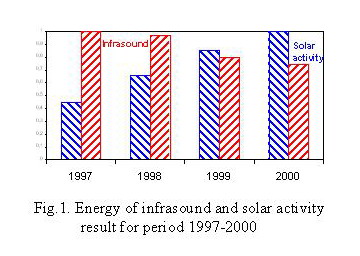
In
Fig. 1 the changes of annual energy of the infrasound and SA for the period
from 1997 to 2000 are shown. The maximal annual energy of the infrasound was
observed in 1997, when SA was minimum. Similar was observed during short-term
(5-10days) changes of SA. The infrasound measurements were carried out at the
Western regional centre of the special control NSAU at a point with
coordinates 48°41¢
N, 26°30¢
E.
The
connection of SA with infrasound in the atmosphere can be presented as follows
(Fig. 2).
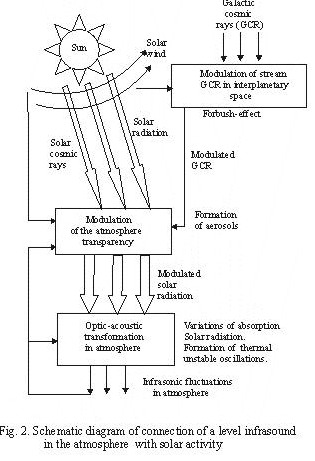
The SA changes result in modulation of GCR. The modulated flow of
GCR during interaction with the bottom atmosphere changes its transparency by
formation of aerosols and variations of small compounds of atmosphere (NO2,
H2O, O3 etc.). The changes of the optical transparency
lead to the spatial variations of the solar energy absorption in the
atmosphere. As a result in various
zones of the atmosphere the temperature gradients and thermal instabilities,
inducing acoustic fluctuation are formed. The formed infrasound can
influence the fluctuation of the intensity of space beams interaction with
atmospheric aerosols. In Fig. 2 the introduction of reverse connection is
shown. The infrasonic fluctuations can strengthen modulation of the
transparency and the effect of opto-acoustic transformation in the atmosphere.
According
to proposed diagram of the infrasound generation in its spectrum the solar
action should be shown.

In Fig. 3 the spectral density of solar activity and
infrasound is shown. The data for the period of 1997-2000 are used. The
realizations of infrasound recordings were centred also smoothed. The
index F10.7 was used for SA evaluation. The spectral density and SA are
well-coordinated with the range of periods of 24-35 days. At higher
frequencies the seismic activity more likely influences IFA.
A daily and a half-day periods in infrasonic fluctuations are well
observed. The diagrams of spectral density of the hour sums of infrasound
modules for the period of about~2 months are shown in Fig.4a,b. In the "quiet"
periods two harmonics only (Fig.4a) are shown. In the interseasonal period at
the presence of disturbances in the atmosphere there appear the additional
harmonics (Fig. 4b).
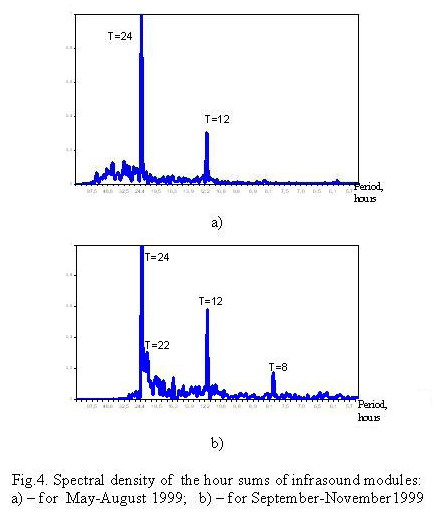
Thus,
spectral analysis of the infrasound has shown the presence of its connection
with SA. It is possible to assume, that the influence of SA on biosphere
occurs through the acoustic channel. Experimental researches [2] have shown
the presence of the infrasound influence on electroconductivity and viscosity
of solutions. The infrasound influence on capillary processes is also revealed.
CONNECTION
of SEISMIC ACTIVITY With infrasound IN
THE ATMOSPHERE
The second
factor that significantly influences IFA, is the seismic activity. The
influence of seismic activity on IFA is very a complex process and does not
consists only in piston radiation of oscillating lithosphere plates. It is
necessary here to take into account the various physicochemical processes both
in lithosphere, and in atmosphere. The
IFA can be caused by gas release from lithosphere cracks during increase of
seismic activity, oscillations of
lithospheric
plates, aerosol heterogeneities
in the atmosphere.
The
IFA can create alternate stresses on the Earth surface and penetrate at
significant depths in lithosphere. Penetrating into lithosphere the infrasonic
fluctuation influence the speed of the movement of fluids, telluric electrical
fields and also on local seismic fluctuations. Such processes occur on the
large territories and can render the essential influence on seismic activity.
Thus, the infrasound in the atmosphere can be both the result of seismic
fluctuations and also actively influence them.
The character of the interchange oscillatory energy between lithosphere
and atmosphere can indicate the processes of preparation of large earthquakes.
To
investigate the acoustic channel of lithosphere -atmospheric connections two
indexes of seismic activity were introduced. First one is proportional to the
square of the maximal magnitude in the given day in the given region, the
second – to the square of the sum magnitudes of all seismic events with
magnitude ³3
for day in the given region. Two regions were considered. One with the sizes
longitude 10°
-45°E
and latitude 35°
-60°
N, and the second: longitude 10°
-55°
E and latitude 20°
-60°
N. The first and the second regions included the basic zones of the increased
seismicity of Central and East Europe
, and also Turkey
. The infrasound was
measured at the point with coordinates 48°-41°
N, 26°-30°
E.
The
connection of seismicity with the infrasound for the period 1997-2000 was
analysed. The spectral
characteristics infrasound and seismic activity agree well.
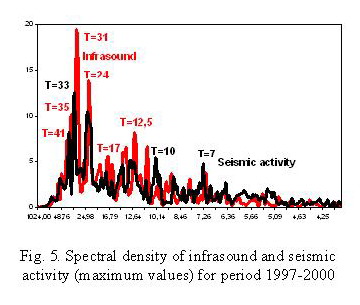
In Fig.5
the spectral density of the daily energy of the infrasound and seismic
activity for the period of 1997-2000 are shown.
The
investigations have shown, that the infrasonic fluctuations
"are sensitive" to the seismic activity changes in radius up to
2000km. The optimum size of the
radius of this area of seismic activity account is in the range of 1000-1500km.
The
greatest interest represents the analysis of IFA before catastrophic
earthquakes in the region close to the point of infrasound measurement.

In
Fig.6 the dynamics of the change of spectral density of the infrasound
envelope before catastrophic earthquake in Turkey
on August 17, 1999
is shown. Approaching
the moment of the earthquake the infrasound spectral density changes, and many
spectral components not typical of the “quiet” period appear.
In “quiet” time in the spectrum density two components with the periods 24
and 12 hours are observed which, most likely, are caused by the change of
solar radiation (day, night). When
approaching the moment of earthquake the daily characteristics of infrasound
also change.
To
analyze the seismic activity the phase portraits widely used in the theory of
dynamic systems were used. In Fig.7 the phase portraits of seismic activity
for the period of 1997-2000 are shown. On the abscissa
axis the values of the index of seismic activity (in the given case the
normalized value of the maximum magnitude square in the given region) are put.
On the ordinate axis the normalized derivative of the function constructed on
the values of the seismic activity index is given.
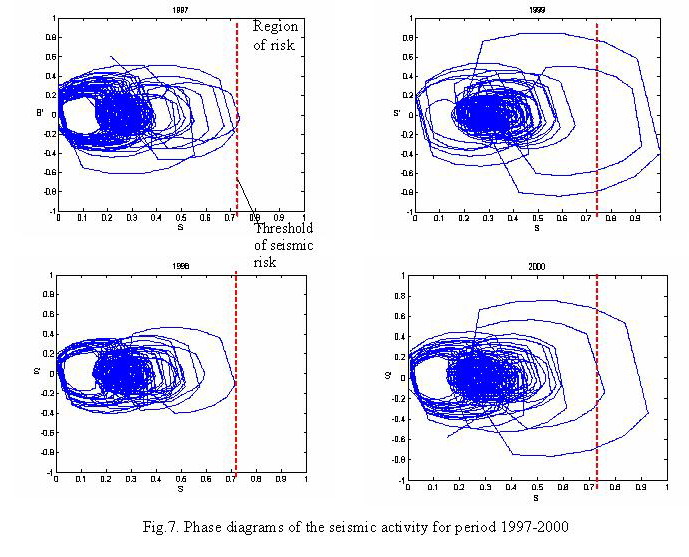
As it is visible from Fig.7
the phase trajectories are attracted to the compact area. Only during
catastrophic earthquakes the phase trajectory leaves the attraction area. And,
the phase trajectory going out from the attraction area and its penetration
into the dangerous area (dotted lines in the picture) do not proceed instantly.
It occurs for some days. In Fig.8 the
phase portraits of seismic activity and infrasound before the catastrophic
earthquake in Turkey
on
August
17, 1999
are shown. The
phase portrait before the earthquake looks like a developed spiral. After the
earthquake the phase trajectory comes back into the area of attraction. It is
interesting to note that the phase portrait of changes of the infrasound daily
energy behaves similarly (Fig.8b).
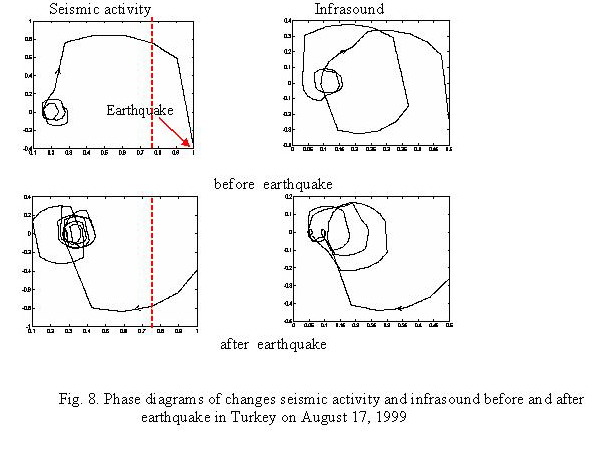
ACTIVE
ACOUSTIC EXPERIMENTS IN THE ATMOSPHERE
The
important research direction of the connection IFA
with processes in geospheres is the artificial acoustic disturbance of the
bottom atmosphere, and subsequent observation of the change of various
geophysical fields. For acoustic disturbance modeling the large ground
explosions were used. In such a way the researches on the influence of ground
acoustic disturbance
on ionosphere were carried
out. The convincing facts confirming the influence of ground explosions on ionospheric
plasma were received. However, recently many researchers put under doubt the
possibility of the acoustic wave passage at ionospheric
heights. They doubt not the fact of the acoustic waves influence in troposphere
on ionospheric
plasma, but only the direct passage of the acoustic wave into ionosphere.
These doubts are based on the large attenuation of acoustic waves in the
atmosphere during their vertical distribution owing to exponential
fall of pressure with height. The pressure decrease causes the increase in the
wave amplitude, transformation of its shape in a triangular one and,
accordingly, the occurrence of nonlinear mechanisms of energy dissipation.
The
purpose of the given research direction was the search of possible mechanisms
explaining the occurrence of the electromagnetic responses to ground acoustic
disturbance and creation of tools for realization of experimental tests.
For
researches of the influences ground acoustic disturbances
on system the atmosphere–
ionosphere
two acoustic stands are created: a stationary (Fig.9a) and a mobile (Fig.9b).
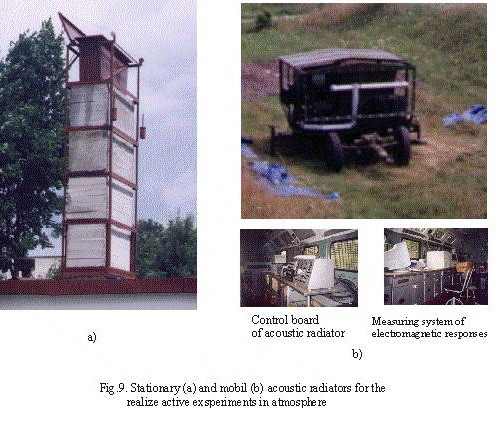
The created equipment has allowed us to make the experiments considerably
cheaper (in thousand times) in comparison with the explosive methods of the
acoustic disturbance of the ionosphere. The stationary acoustic stand was used
for the extensive experimental researches and the basic laws of the
electromagnetic responses to acoustic disturbance of the atmosphere were
established [4].
In
Fig.10 the typical changes of geomagnetic variations in the range of 1-40Hz
are shown. On the diagrams the energy of a magnetometer signal in the range of
1-40Hz before and after acoustic disturbance is presented. The character of
signals changed for a durable time.
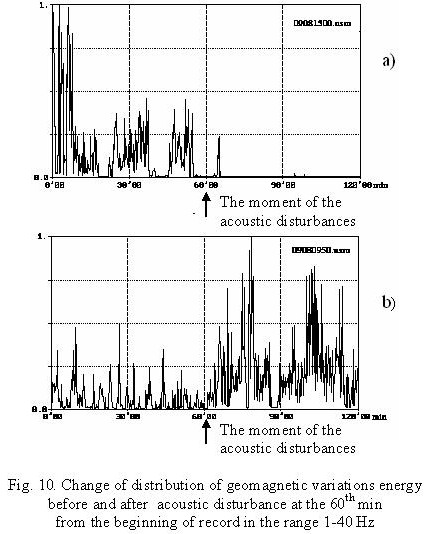
In some cases the signal energy grew
(Fig.10b), in others decreased (Fig.10à).
These signals are not compatible with the Galperin-Hayakava
well-known model.
It is impossible to explain the signal decrease after acoustic disturbance by
the presence in the atmosphere of only the mechanism of amplification.
To
explain such strange behaviour of the signals - responses the hypothesis was
put forward, that in the atmosphere there exist own generators of the infrasound.
In some cases, under external acoustic influence, they strengthen the infrasound
generation, and in
others - the external acoustic influence destroys the atmospheric generators.
In the atmosphere there is an original acoustic “trigger” mechanism. For
this purpose it is necessary to assume, that in the atmosphere there is a
hidden energy. In fact, the atmosphere cannot be considered as a passive
environment consisting of the gases mixture. In the atmosphere there are
chemical reactions, phase transitions of water, ionization under action of
solar radiation and weathering of the radioactive dust from the Earth surface.
All these processes result in spatial variations of release and absorption of
energy in the atmosphere and formation of thermal instabilities. Spatial
thermal heterogeneity in certain conditions can result in generation of the
infrasound in the atmosphere. Local changes of atmospheric environment during
the influence of the external acoustic wave can cause the additional release
of thermal energy and, accordingly, amplification of acoustic waves generation.
In this situation energy from environment passes in the acoustic wave. This
process can be considered as the original acoustic “laser”. It is
necessary to note, that the frequency of atmospheric acoustic fluctuations
caused by external acoustic influence will not coincide with frequency of the
influence. The external acoustic influence is a “trigger
hook” for start of the large-scale atmospheric processes. In this case the
energy from internal reservoirs of the atmosphere passes into acoustic
fluctuations. In certain situations the external acoustic influence can
destroy the atmospheric generators. In this case a level infrasound
should decrease and, accordingly, the electromagnetic signals - responses also
decrease. Three possible mechanisms of amplification of
the infrasound in
an atmosphere are offered [5].
The
large-scale experiments related with observation of the atmospheric infrasound
before and after powerful acoustic influence of duration of 1-3min
were carried out.
The mobile acoustic emitter
with electric drive (560kVt) was established at a distance of ~300m from the
infrasound measuring system. The
characteristic changes in the infrasound
amplitude and geomagnetic
variations before acoustic disturbance (Fig.11) were found.
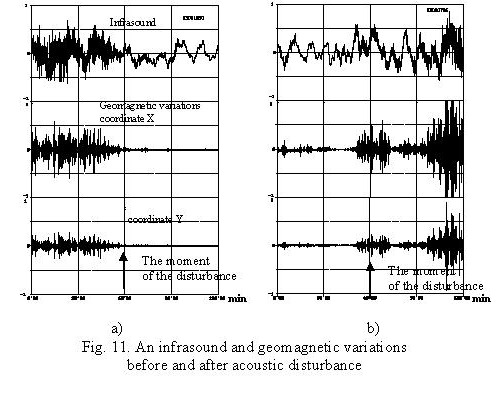
The short-term acoustic influence resulted in the increase in the infrasound
amplitude (Fig.11b), or in its decrease (Fig.11a). The synchronous
measurements of geomagnetic variations have shown, that they change in a
similar way (Fig.11). With the increase of the infrasound
intensity the
geomagnetic variations also increase (Fig.11b) and vice versa (Fig.11à).
The spectral analysis has proved, that in the range of the periods from tens
of minutes up to tens of seconds the spectra of the infrasound
and geomagnetic variations have the identical character. The low-frequency
part of the infrasound
spectrum and of the geomagnetic variations is shown in Fig.12.
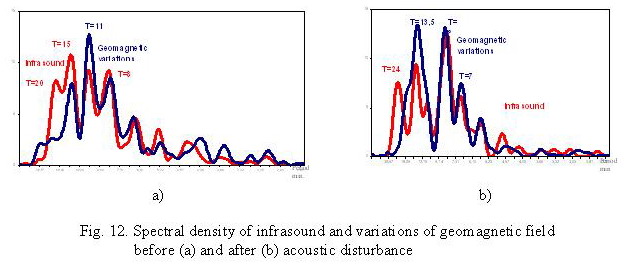
Thus,
it was experimentally proved, that the short-term acoustic influence of high
intensity changes the character of infrasonic
fluctuations in the atmosphere for a long time. Reaching
the ionospheric
heights, the infrasonic
fluctuations influence the ionospheric
electrical
currents and cause the changes of the geomagnetic field.
CONCLUSIONS
1.
The analysis of the infrasound spectrum for the period of 1997-2000 has
shown the presence of frequencies with the periods typical of solar activity
of 27 days, 24 hours, 12 hours. The energy of infrasound grows with decrease
in the solar activity. The possible mechanism of the influence of solar
activity on the infrasound in the atmosphere is proposed.
2.
The changes in the infrasound spectrum caused by lithospheric processes
were found. During 5-10 days prior to large earthquakes the spectrum of
infrasonic fluctuations in the atmosphere changes essentially, that can become
a basis for creation of a new method of the earthquakes prediction. The phase
diagram of the infrasound before a large earthquake looks like an untwisted
spiral.
3.
The effect of amplification a sound in the atmosphere was found for the
first time. Short-term (~60sec) intensive acoustic influence on the atmosphere
results in increase of the infrasonic fluctuations, which fade during a long
time. Three possible mechanisms of this effect are proposed: condensation,
chemical and relaxation of nonequilibrium warmed-up gas. In general, it can be
formulated as the presence of nonequilibrium states in the atmosphere, which
under the acoustic waves influence generate infrasound in the wide frequency
range.
4.
The range of frequencies is experimentally determined, in which the
infrasound influences the ionospheric currents. The spectral densities of
geomagnetic variations and infrasound coincide in the range of periods from
1 to 20 min.
5.
It is worth conducting the
further active acoustic researches of ionosphere by synchronous ground and
satellite measurements of the electromagnetic responses to ground acoustic
disturbance. Such researches will allow us to prove the possibility of
creation of the system of satellite monitoring of the Earth processes, which
are accompanied by intensive acoustic radiation.
6.
It is worth expending the researches of the influence infrasound on
biospheric processes and biological objects at the different levels of
organization. It is possible, that by means of infrasound the of solar
activity on the Earth influences the biosphere.
REFERENCES
1.
Negoda A.A.,
Soroka S.A.
The acoustic channel of
space influence on biosphere of the Earth. Space science and tecnology, 2001,
v.7, #5/6, p 85-93.
2.
Soroka S.À
Solar activity and infrasonic
fluctuation in the atmosphere of the Earth. The theses of the reports of the
third All-Russia scientific conference “ Physical problems of ecology (ecological
physics) ”. Moscow, 2001, p. 48-49.
3.
Znak Z.Î.,
Negoda
À.À.,
Soroka S.À.,
Acoustic fluctuations in an atmosphere as the possible channel of space
influence on biosphere. The theses of the reports of the IInd Ukrainian
conference on perspective space researches. Kathsively,
2002, p. 152.
4.
Kalita B., Mezentcev V., Soroka S. Electromagnetic responses during
acoustic disturbance in atmosphere. III International Workshop on Magnetic and
Electromagnetic Methods in Seismology and Volcanology (MEEMSV-2002).
Moscow, 2002, p.205.
5.
Soroka S.A. To Galperin-Hayakava Model of Influence of Ground Acoustic
disturbance on Ionosphere. International Symposium in memory of Professor Yuri
Galperin. Aureal Phenomena and Solar-Terrestrial Relations. Moscow
, 2003, p.101.
|
